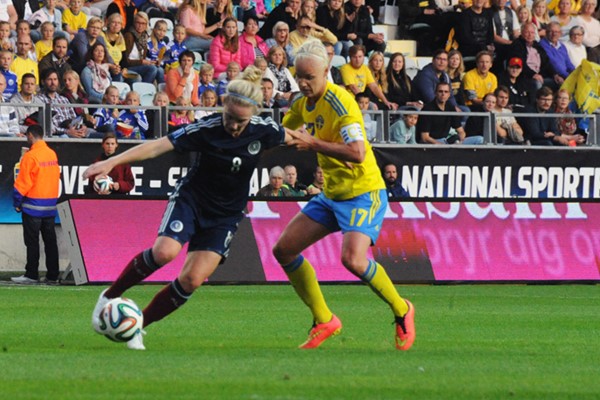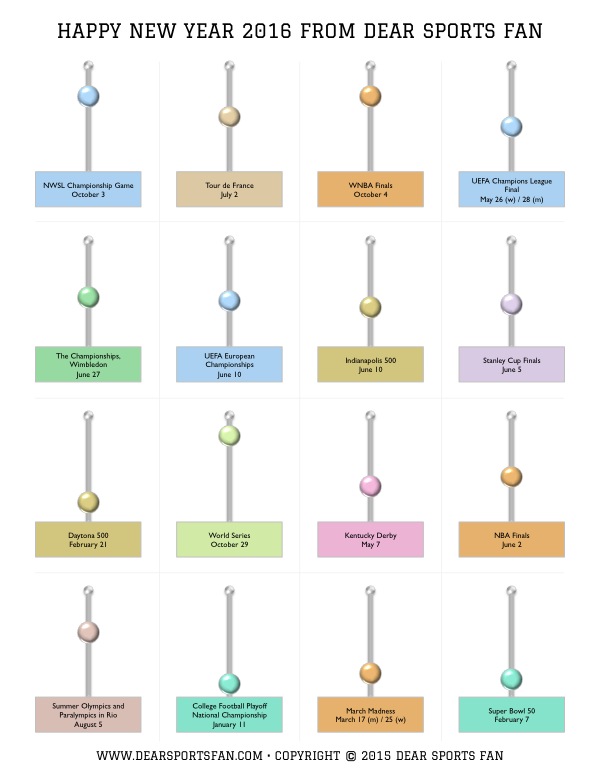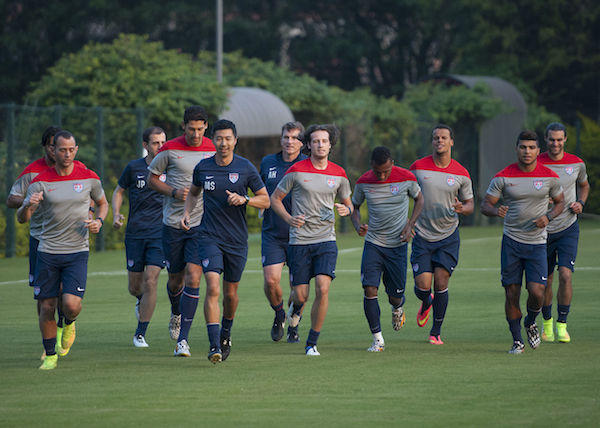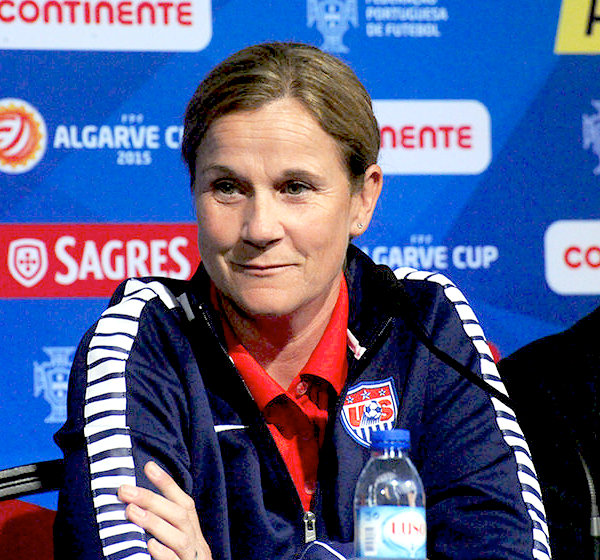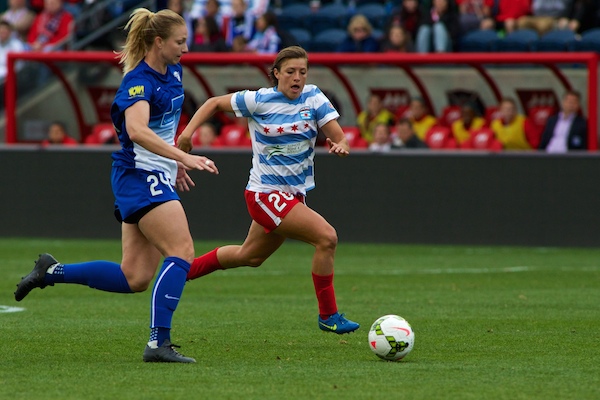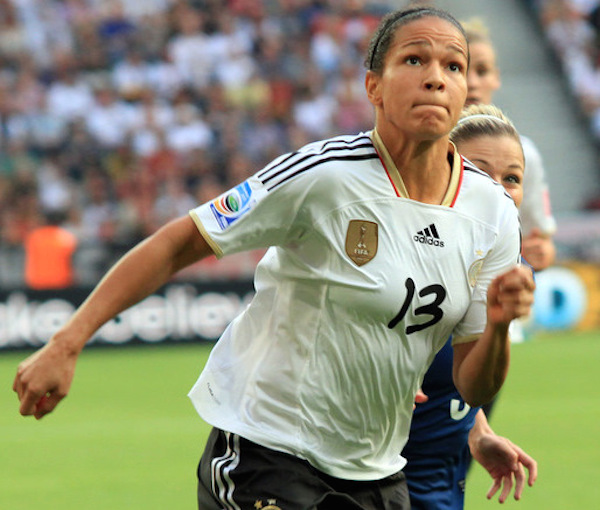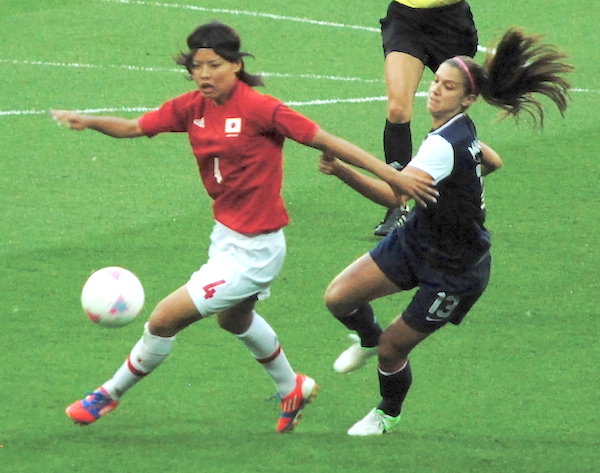This past Tuesday, I had the rare pleasure of being at a wonderful and historic sporting event live! I was part of the 51,000 person crowd in Montreal’s Olympic Arena to witness the United States women’s national soccer team beat Germany 2-0 in the semifinals of the 2015 World Cup. It was a sublime experience and I wrote about it from a spectator’s perspective the following day. One of the things that struck me was how different it was to watch the game in person from watching it on TV. Some things were more intense, others more distant. When I got home from Montreal, I decided to watch the game as it was seen by the 8.4 million people who watched it on television. In the spirit of Bill Simmons I took notes as I watched to create a “retro diary” of the game. I hope you enjoy!
0:00 – Whoa! This is weird. It takes me a minute to reposition my viewpoint from where I was on Tuesday (about 20 rows up in one corner of the stadium) to where the television camera is (floating in midair around the halfway point.)
1:30 — The Germans came out well at the start of this game. They’re pressuring the U.S. defense and causing some turnovers right away.
2:30 — More than two minutes in and the United States still hasn’t had the ball in the attacking half. I remember feeling very, very nervous about that in person.
3:00 — The first of many times that German striker Celia Sasic gets the ball and is shut down immediately by 3 to 4 U.S. players coming from every direction.
4:30 — U.S. defender Julie Johnston’s dramatic night begins when she falls on the ball and it knocks the wind right out of her.
6:30 — Johnston almost scores on one of her classic near post runs on a corner. I totally forgot about this – great save by the German goalie, Nadine Angerer.
9:00 — Megan Rapinoe makes a nice move in the box but scuffs her shot. Was this Rapinoe’s only offensive chance? She created havoc in the midfield though, so that’s okay.
12:10 — Boos heard from the crowd after a clear foul from Carli Lloyd. Amazing how partisan being there in person makes you — I remember being a part of that wrongful booing. and feeling really righteous about it.
13:50 — Tobin Heath springs Alex Morgan with a ridiculous through ball and Morgan wastes it by slapping the ball right at the goalie’s feet. How good could the U.S. be if Morgan had scoring touch at all?
15:00 – Announcer says “this is a game of mentality against mentality and the U.S. is winning that battle right now.” I have no idea what that means but it sounds good.
22:45 — Johnston slow to get up again after a foul.
28:15 — The head to head clash between Alexandra Popp and Morgan Brian was much more dramatic on TV. Amazing the difference closeups and replays make compared to something happening once way on the other side of the field. The German team all runs to the sideline to talk and drink water. The U.S. team sticks near their fallen teammate. In person, we could see the coaches on the sidelines screaming at their players and motioning them to move away. Meanwhile, on television, the German injury looks far worse — very bloody. Also in person, as SOON as the players went down, all the American subs started warming up. I’m not sure what the rules are, but generally there were players warming up much more frequently than I thought there would be. During most of the half, someone from the U.S. team was alway warming up although only in batches of three. Announcers say that “thankfully” players are no longer making the decision to go back into the game after head injuries — but if they’re not, who is? No concussion protocol I know of only takes a few min or can be done in a noisy, in-stadium atmosphere.
32:00 — After a five minute delay, the players are up and the game restarts.
33:00 — Rapinoe steals another ball in the midfield and forces a yellow card. Great example of her embracing a less offensive role.
35:00 — The start of a great sequence for the U.S. A Meghan Klingenberg shot deflects for a corner. A nice move by Johnston in the box (how versatile is she?) leads to another corner. Then a scramble in front of the goal leads to ANOTHER corner. The crowd is standing and cheering. I remember feeling like we’d surely get a goal on one of these corners. Then all of a sudden, a clearance by Sasic, a bad pass by Ali Krieger, and Becky Sauerbrunn has to take a professional foul and gets a yellow card. Germany broke the momentum.
43:00 — Morgan misses another chance by barely a foot. Takes a sweet pass from Sauerbrunn, dances by a German defender… and kicks the ball way past the far post. Gah!
45:00 — Only four minutes of stoppage time despite a five minute stoppage for the Brian/Popp head clash. This is one of the reasons why soccer players dive and roll around and do all sorts of other stuff to waste time. Referees don’t actually stop their watches all the time when that’s happening. Or if they do, they don’t add the time back later.
46:00 – Popp fouls Rapinoe. Live, I remember thinking this should have been the second yellow on Leonie Maier and howling my indignation. Nope, the offender was a different blonde German player! Shows you what I know.
47:00 — Now Maier fouls Rapinoe. Oh wait, maybe THIS was the foul I was upset about. Right, wrong? Whatever. No second yellows. But by the end of the half, the crowd thought the ref was screwing us — which is maybe why we didn’t pick up on the fact that she saved us in the second half.
Halftime — Former soccer player, Ariane Hingst on the major clashing of heads in the first half: “Popp with the bloody head. Morgan, she looked like as if she was concussed. And really, well done by the players they stood up and continued to play. The comment of studio host Rob Stone? “Well done by the officials to make sure everyone was okay to move on.” This dichotomy tells you everything you need to know about how players view head injuries differently from media members/normal people.
46:00 — The U.S. wins a seventh corner. That’s a lot and way more than the Germans, who did well not to let in a goal off one of these corner. This one was a close call after Lloyd headed it just a few feet wide. Despite her upcoming heroics, was this the first time Lloyd did something noticeable? I think so — she was less present in the first half.
50:00 — Heath just straight up gives away a corner. No idea what she was trying to do there but we in the crowd, like the announcers on TV, were not happy with her.
51:00 – Commentator Cat Whitehill says she’s never seen a German team play so poorly. Would have been nice to hear that in the crowd. Although I knew we were dominating play, I was still scared constantly.
54:30 — Heath makes another amazing pass to spring Krieger up the field. I appreciate the game Heath had much more on second viewing. She did a lot of clever things to help the U.S. get forward.
56:50 – A zoomed in camera catches Popp heading the ball and grimacing. Imagine heading the ball with a brand new head wound. OUCH!! Definitely harder to see things like that in person.
58:00 – THE MOMENT. It came on suddenly. At first, the German pass looked like an innocuous half-clearance attempt but a giant bounce and a suddenly surging Popp put Johnston in a bad situation. In defense of the ref, I understand why she wouldn’t give a red card. If the red card had been given it would have been because Johsnton had clearly taken away a German scoring attempt. From the start of the play, it didn’t seem like there was about to be a goal scoring opportunity. It was a totally nothing play. Sasic lines up to take the shot. Goalie Hope Solo starts playing head games. Sasic has her hands on hips. Wild cheering and clapping from the crowd. TV announcers say they are “surprised” Solo didn’t get a yellow card. Sasic misses. Wow! The announcers do a great job of staying out of the way to help the drama of the moment. There are shots of the pro-American crowd going wild and wry German fans. The game moves on so quickly with chants of USA, USA clearly audible. The whole sequence only took two minutes but it felt like a lifetime in the stands. Must have felt like ten lifetimes for Johnston who, according to the announcers, was crying on the field. Also according to the announcers, this was the first time the Germans had missed a penalty kick in WC history. WHAT? SERIOUSLY? THAT’S AN INTERESTING TIDBIT!
62:15 — German, Anja Mittag has the next good scoring chance after the missed penalty. Any history of the game (even mine) that suggests the American victory was foretold as soon as the penalty kick was missed is wrong and seriously revisionist.
64:00 — Putting a defender up as part of the attack on corners puts such pressure on that player to get back if the corner turns into a counter-attack. Even more stress on Johnston who has to sprint back after a Lauren Holiday corner goes bad.
65:00 — Krieger wins a corner – I was really impressed with her skill close in with the ball throughout this game.
66:00 — Another great long ball on the ground from the U.S. defense straight through the midfield to Alex Morgan. I wonder if that was an intentional tactic installed by the coaching staff before the game. It seems like a surprising number of passes, including both the passes that led to goals were from the defense all the way up to the foremost attacker. This time it was from Klingenberg to Morgan. Morgan misses again on a difficult angle shot.
66:35 –The play that eventually leads to the U.S. getting a penalty kick starts with Carli Lloyd winning a hardcore 50/50 ball in midfield. She made a clean play to knock the ball to Klingenberg while at the same time injuring the German player she was going up against. Clearly the Germans were not ready for the power of New Jersey. Perhaps no one truly is. Klingenberg settles the ball and passes, again through the midfield straight to Morgan. It’s a nothing play from then on — Morgan runs at the German defense, makes a single move, and gets fouled. If you rewind and watch this play several times, you’ll be struck by how clearly it seems to be foreshadowed. Watch Annike Krahn’s footwork as she prepares to meet Alex Morgan’s rush. It’s terrible! It almost feels as though she’s going to stumble and fall before she can even make an attempt to get the ball from Morgan. Injury, fatigue, or fear? Something was up with her.
68:30 — Lloyd is a rock. Celebrates with a giant F-Bomb.
74:00 – Kelley O’Hara comes in and there’s a lot of communication between her and other players. Relaying instructions about how things are supposed to change with her on the field.
75:25 — Brian intercepts a pass in the center of the midfield. It’s going to be interesting to see how her role develops. At 22, she’s adjusting her role to facilitate other players preferences but given how well played, even in a non-natural role, soon she’ll begin to force other players to accommodate her.
77:00 — Germany looks tired. Who knows how much the 120 minute quarterfinal game against France took out of them. The draw was unfair not just to the French but to the Germans too.
78:10 — Totally gratuitous shot of Solo drinking water and squirting herself with it. The announcers do a good job not commenting.
79:00 – Abby Wambach enters the game for Rapinoe and the announcers have same concern with the substitution that I did in the stands. Does it change the team’s shape? It was hard to imagine that Wambach would play midfield which she basically did until after the next goal.
81:00 – Maier skies what may have been Germany’s last legitimate chance to score. How much of this was tired legs? How much was knowing that you had to take a near perfect shot to beat the intimidating Solo?
83:00 — The final scoring sequence starts with Wambach running down a ball played a little too far to the flag. She corrals it, plays it back to Klingenberg who plinks it into the box. Lloyd takes the pass, beats her defender, and seemingly for the first time all game (thanks Morgan) throws the ball across the face of the goal instead of trying to score from a tight angle. O’Hara, with the freshest legs on the field, was not going to be denied that ball. In the replay you can almost see the determination in her stride as she powers past the German defender and cleats the ball into the net.
87:30 — The Germans are dead women walking and they know it.
92:30 — The moment of confusion I wrote about when the Leroux sub made me think the game was over may have mostly just been in the crowd. One German player does drop to the ground but most on both sides look like they know the game isn’t over.
Game over — The camera lingers on a handshake line between the two teams and particularly Popp with fresh blood dripping down the side of her face. It’s easy to forget that many of these players have played together in the NWSL or other soccer leagues. They have lots of respect for one another.

